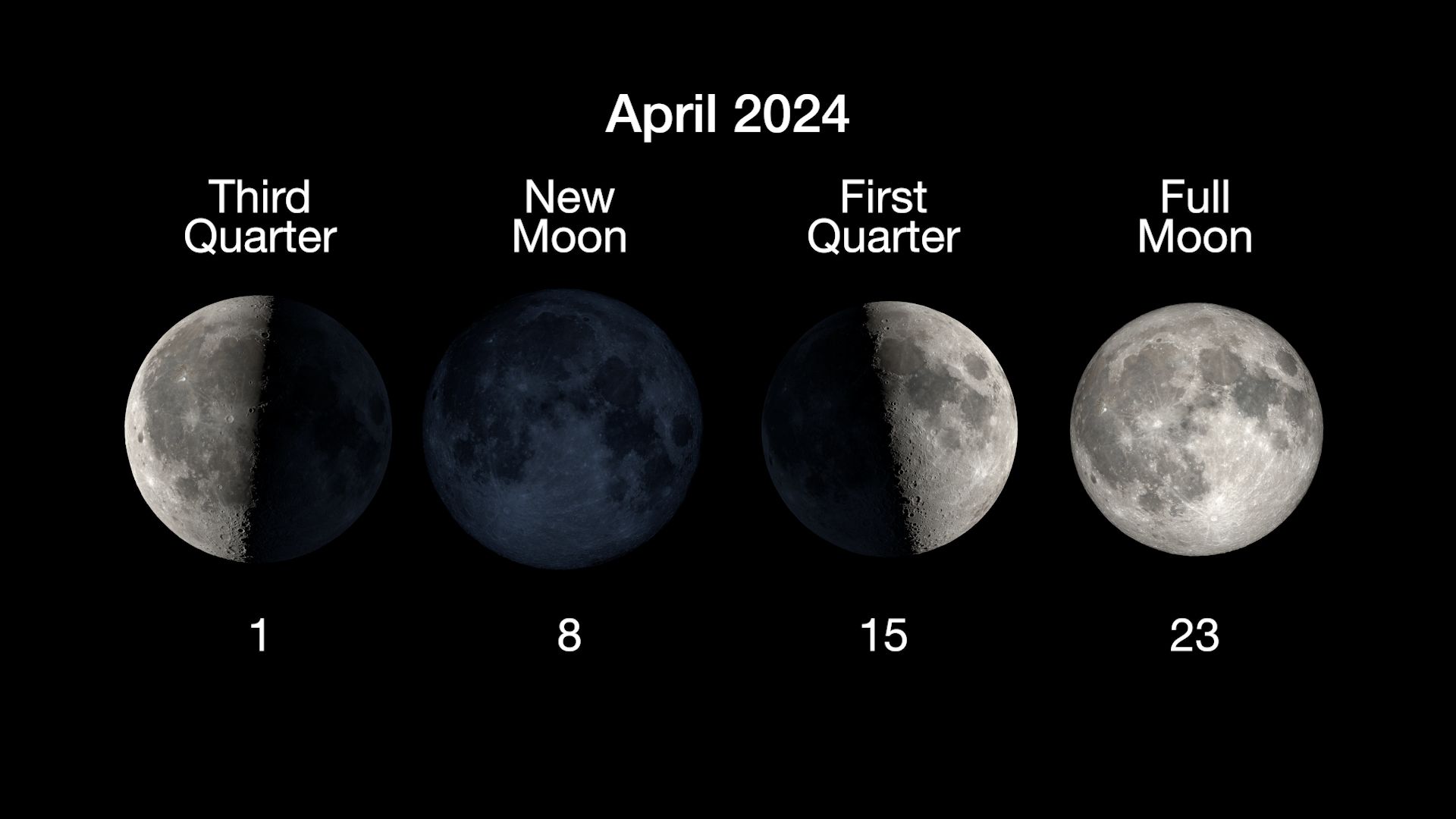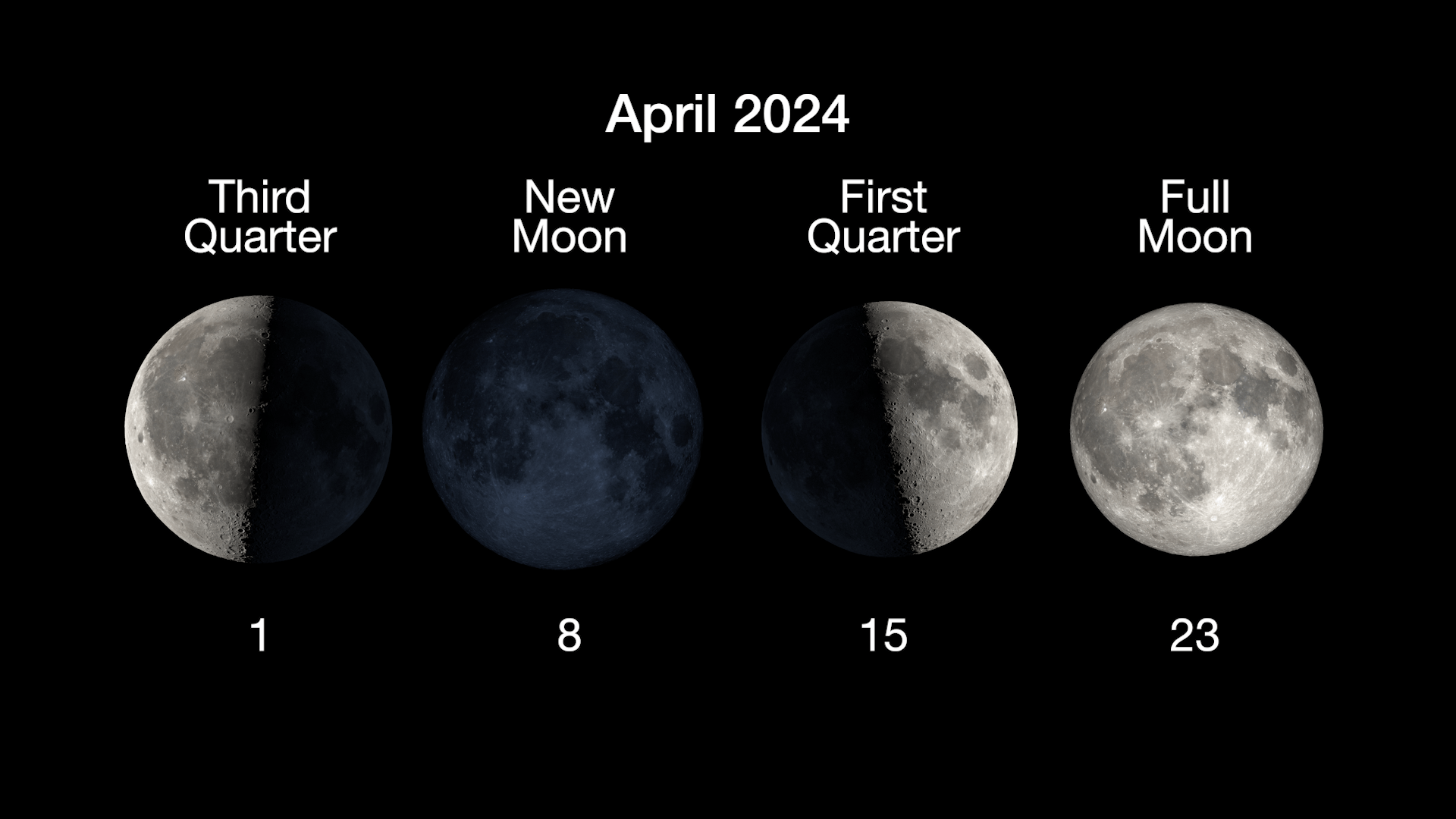The next full Moon is the Pink Moon, Sprouting Grass Moon, Egg Moon, Fish Moon, the Pesach or Passover Moon

The next full Moon is the Pink Moon, Sprouting Grass Moon, Egg Moon, Fish Moon, the Pesach or Passover Moon, the Hanuman Jayanti Festival Moon, and Bak Poya.
The next full Moon will be Tuesday evening, April 23, 2024, appearing opposite the Sun (in Earth-based longitude) at 7:49 PM EDT. This will be on Wednesday from the time zones of the UK, Ireland, and Portugal eastward across Europe, Africa, Asia, and Australia to the International Date Line in the mid-Pacific. The Moon will appear full for about 3 days around this time, from Monday morning to Thursday morning.

The phases of the Moon for April 2024
NASA/JPL-Caltech
The Maine Farmers’ Almanac began publishing “Indian” names for full Moons in the 1930s and these names are now widely known and used. According to this almanac, as the full Moon in April the tribes of the northeastern United States called this the Pink Moon, named after the herb moss pink, also known as creeping phlox, moss phlox, or mountain phlox, a plant native to the eastern USA that is one of the earliest widespread flowers of spring. Other names for this Moon include the Sprouting Grass Moon, the Egg Moon, and among coastal tribes the Fish Moon, as this was when the shad swam upstream to spawn.
This is the Pesach or Passover Moon. In the Hebrew calendar this full Moon is in the middle of Nisan, with Pesach or Passover beginning on the 15th day of Nisan. Pesach or Passover begins at sundown on Monday, April 22, and ends at nightfall on April 30, 2024. The Seder feasts are on the first two evenings of Passover.
There are a number of variations of the Hindu lunisolar calendar, but for most regions this full Moon corresponds with the Hanuman Jayanti festival, the celebration of the birth of Lord Hanuman.
For Buddhists, especially in Sri Lanka, this full Moon is Bak Poya, commemorating when the Buddha visited Sri Lanka and settled a dispute between chiefs, avoiding a war.
This full Moon is near the middle of ShawwÄl, the tenth month of the Islamic calendar and the middle of the third month of the Chinese year of the Dragon.
As usual, the wearing of suitably celebratory celestial attire is encouraged in honor of the full Moon. Enjoy the early flowers and sprouting grass of spring, leave an extra seat at the table, and avoid starting any wars!
As for other celestial events between now and the full Moon after next (with specific times and angles based on the location of NASA Headquarters in Washington, DC):
As spring continues the daily periods of sunlight continue to lengthen, having changed at their fastest around the equinox on March 19, 2024. On Tuesday, April 23 (the day of the full Moon), morning twilight will begin at 5:18 AM EDT, sunrise will be at 6:20 AM, solar noon will be at 1:06 PM when the Sun will reach its maximum altitude of 64.0 degrees, sunset will be at 7:53 PM, and evening twilight will end at 8:56 PM. By Thursday, May 23 (the day of the full Moon after next), morning twilight will begin at 4:40 AM, sunrise will be at 5:49 AM, solar noon will be at 1:05 PM when the Sun will reach its maximum altitude of 71.9 degrees, sunset will be at 8:21 PM, and evening twilight will end at 9:30 PM.
Meteor Showers
This year, the Aquariids (031 ETA) meteor shower is predicted to peak the afternoon of May 5, 2024 (when we can’t see them from the Washington, DC area). If you are in the tropics or the southern hemisphere, the predicted peak rate (under the best possible conditions) is about 50 visible meteors per hour (called zenithal hourly rate or ZHR). However, this meteor shower has a broad peak. As reported by the International Meteor Organization, data since 1984 show that ZHRs are generally above 30 from May 3 to May 10 and modeling suggests there may be enhanced activity near the peak sometime between May 4 and May 6.
Viewing conditions from the Washington, DC area will be far from ideal, as DC is on the northern edge of visibility. With the ZHR relatively low (compared to the three big meteor showers of the year) and the radiant low on the horizon, viewing these meteors from our light-polluted urban areas will be difficult. But if you find yourself out in the early morning between May 3 and May 10 in an area with clear, dark skies and a clear view towards the east-southeastern horizon, you may see some meteors! These meteors are caused by debris from Halley’s Comet entering our atmosphere at 66 kilometers per second (148,000 miles per hour).
For the DC area the time to look closest to the peak should be the early morning of Monday, May 6. The radiant (the point that the meteors will appear to radiate out from) will rise on the eastern horizon (around 2:35 AM EDT) about 2.5 hours before morning twilight beings. At radiant rise, half of the meteors are hidden by the horizon, so the higher the radiant, the better the viewing. The radiant will be about 27 degrees above the east-southeastern horizon by the time morning twilight begins (at 4:59 AM), so the hour or so before this should be the best time to look.
If you go looking for these meteors, be sure to give your eyes plenty of time to adapt to the dark. The rod cells in your eyes are more sensitive to low light levels but play little role in color vision. Your color-sensing cone cells are concentrated near the center of your view with more of the rod cells on the edge of your view. Since some meteors are faint, you will tend to see more meteors from the “corner of your eye” (which is why you need to view a large part of the sky). Your color vision (cone cells) will adapt to darkness in about 10 minutes, but your more sensitive night vision rod cells will continue to improve for an hour or more (with most of the improvement in the first 35 to 45 minutes). The more sensitive your eyes are, the more chance you will have of seeing meteors. Even a short exposure to light (from passing car headlights, etc.) will start the adaptation over again (so no turning on a light or your cell phone to check what time it is).
Evening Sky Highlights
On the evening of Tuesday, April 23, 2024 (the evening of the day of the full Moon), as twilight ends (at 8:56 PM EDT), the rising Moon will be 10 degrees above the east-southeastern horizon. The bright planet Jupiter will be 4 degrees above the west-northwestern horizon. The bright object appearing closest to overhead will be Regulus at 63 degrees above the southern horizon. Regulus is the 21st brightest star in our night sky and the brightest star in the constellation Leo the lion. The Arabic name for Regulus translates as “the heart of the lion.” Although we see Regulus as a single star, it is actually four stars (two pairs of stars orbiting each other). Regulus is about 79 light-years from us.
As this lunar cycle progresses, Jupiter and the background of stars will appear to shift westward each evening (as the Earth moves around the Sun). April 29 will be the last evening Jupiter will be above the west-northwestern horizon as evening twilight ends. The waxing Moon will pass by Pollux on May 12, Regulus on May 15, and Spica on May 19.
By the evening of Thursday, May 23 (the evening of the day of the full Moon after next), as twilight ends (at 9:30 PM EDT), the rising Moon will be 4 degrees above the southeastern horizon with the bright star Antares just off the edge of the Moon. For parts of South and Central America, as well as the Caribbean and parts of the eastern USA (including DC) the Moon will be passing in front of Antares, blocking it from view. The bright object appearing closest to overhead will be Arcturus at 60 degrees above the east-southeastern horizon. Arcturus is the brightest star in the constellation Boötes the herdsman or plowman and the 4th brightest star in our night sky. It is 36.7 light years from us. While it has about the same mass as our Sun, it is about 2.6 billion years older and has used up its core hydrogen, becoming a red giant 25 times the size and 170 times the brightness of our Sun.
Morning Sky Highlights
On the morning of Tuesday, April 23, 2024 (the morning of the day of the full Moon), as twilight begins (at 5:18 AM EDT), the setting full Moon will be 7 degrees above the west-southwestern horizon with the bright star Spica 2.5 degrees to the lower left of the Moon. The planet Mars will be 5 degrees above the eastern horizon and the planet Saturn will be 7 degrees above the east-southeastern horizon. The planet Mercury will rise 22 minutes after morning twilight begins and will be faint, making it difficult to see in the glow of dawn. The bright object appearing closest to overhead will be the star Vega at 86 degrees above the eastern horizon. Vega is the brightest star in the constellation Lyra the lyre and is one of the three bright stars in the “Summer Triangle” along with Deneb and Altair. Vega is the 5th brightest star in our night sky, about 25 light-years from Earth, twice the mass of our Sun, and shines 40 times brighter than our Sun.
As this lunar cycle progresses, Saturn and the background of stars will appear to shift westward each evening, while Mars will hover low on the eastern horizon, drifting slightly to the left. Mercury will brighten and shift higher in the eastern sky, making it easier to see in the glow of dawn, but will not rise until after morning twilight begins. Mercury will reach its greatest angular separation from the Sun on May 9. The waning Moon will pass by Antares on April 26 and 27, Saturn on May 4, Mars on May 5, and Mercury on May 6. Although viewing conditions will not be good from the DC area (and latitudes farther north), the η-Aquariids meteor shower will be near its peak from May 3 to May 10, with our peak viewing expected the hour or so before morning twilight begins on May 6.
By the morning of Thursday, May 23 (the morning of the day of the full Moon after next), as twilight begins (at 4:40 AM EDT), the setting full Moon will be 7 degrees above the southwestern horizon. The planet Mars will be 10 degrees above the eastern horizon and the planet Saturn will be 22 degrees above the east-southeastern horizon. Mercury will rise on the east-northeastern horizon 14 minutes after morning twilight begins. The bright object appearing closest to overhead will still be the star Vega at 78 degrees above the western horizon, with Deneb a close second at 76.5 degrees above the northeastern horizon.
Detailed Daily Guide
Here for your reference is a day-by-day listing of celestial events between now and the full Moon after next. The times and angles are based on the location of NASA Headquarters in Washington, DC, and some of these details may differ for where you are (I use parentheses to indicate times specific to the DC area).
Wednesday evening into Thursday morning, April 17 to 18, 2024, the bright star Regulus will be to the lower left of the waxing gibbous Moon. As twilight ends (at 8:49 PM EDT) Regulus will be 7.5 degrees from the Moon. When Regulus sets on the west-northwestern horizon (at 4:12 AM) it will be 4.5 degrees from the Moon.
Thursday evening into Friday morning, April 18 to 19, 2024, the waxing gibbous Moon will have shifted to the other side of the bright star Regulus. As twilight ends (at 8:50 PM EDT) Regulus will be 6 degrees to the upper right of the Moon. About 1 hour later (at 9:53 PM) the Moon will reach its highest for the night with Regulus 6 degrees to the right. Regulus will rotate clockwise and away from the Moon as the night progresses, reaching about 8 degrees to the lower right around 3 AM.
Friday night, April 19, 2024, at 10:09 PM EDT, the waxing gibbous Moon will be at apogee, its farthest from the Earth for this orbit.
Friday morning, April 19, 2024, will be the first morning that the planet Mercury will rise on the eastern horizon more than 30 minutes before sunrise, a very rough estimate of the earliest it might start being visible in the glow of dawn. Mercury will be quite faint, but will brighten each morning as it shows a larger illuminated crescent towards the Earth. However, this will not be a favorable apparition for Mercury viewing, as even at its highest it will not rise before twilight begins.
Sunday, April 21, 2024 will be when the comet 12P/Pons-Brooks will be at its closest to the Sun. The week or two before this might be a good time to look for this comet with binoculars. If the trail of gas and dust the comet is giving off doesn’t change significantly (a very big and uncertain “if”) then the brightness of the comet should increase to a maximum on April 21. However, interference from the light of the waxing Moon will also increase beginning April 9, and the comet will shift closer to the horizon each evening. As twilight ends on April 21 (at 8:53 PM EDT) the Moon will be 96% illuminated and the comet will be only 2.7 degrees above the horizon. April 24 will be the last evening the comet will be above the horizon before evening twilight ends (at 8:57 PM).
Monday, April 22, 2024, is International Mother Earth Day. See https://www.un.org/en/observances/earth-day for more information.
Monday evening into Tuesday morning, April 22 to 23, 2024, the bright star Spica will be to the lower right of the full Moon. Spica will be a little more than 1 degree from the Moon as twilight ends and will shift closer until little before midnight, after which they will separate again. Spica will be 1 degree from the Moon as the Moon reaches its highest for the night (at 12:31 AM EDT) and will be 2.5 degrees from the Moon as twilight begins (at 5:18 AM).
As mentioned above, the full Moon will be Tuesday evening, April 23, 2024, at 7:49 PM EDT. This will be on Wednesday from the time zones of the UK, Ireland, and Portugal eastward across Europe, Africa, Asia, and Australia to the International Date Line. The Moon will appear full for about 3 days centered on this time, from Monday morning to Thursday morning.
Friday morning, April 26, 2024, the bright star Antares will be near the waning gibbous Moon. Antares will be about 8 degrees to the lower left around midnight, about 7 degrees to the left around the time the Moon reaches its highest for the night (at 2:48 AM EDT), and about 6 degrees to the upper left as morning twilight begins (at 5:13 AM). For parts of the Arabian Peninsula, the Horn of Africa, and the Indian Ocean, the Moon will actually block Antares from view. See http://www.lunar-occultations.com/iota/bstar/0426zc2366.htm for a map and information on the areas that can see this occultation.
By late Friday night into Saturday morning, April 26 to 27, 2024, the waning gibbous Moon will have moved to the other side of the bright star Antares. As the Moon rises (at 11:09 PM EDT) Antares will be 4 degrees to the upper right, and will shift clockwise and away from the Moon as the night progresses, appearing 6 degrees to the upper right when the Moon is at its highest (at 3:42 AM) and 7 degrees to the lower right as morning twilight begins (at 5:12 AM).
Monday evening, April 29, 2024, will be the last evening that the planet Jupiter will be above the west-northwestern horizon as evening twilight ends (at 9:03 PM EDT).
Wednesday morning, May 1, 2024, the waning Moon will appear half-full as it reaches its last quarter at 7:27 AM EDT (when the Moon will be visible in our daylight sky).
Saturday morning, May 4, 2024, the planet Saturn will be 6 degrees to the upper right of the waning crescent Moon with the planet Mars 9 degrees to the lower left of the Moon. On the eastern horizon, Saturn will rise first (at 3:51 AM EDT), the Moon next 17 minutes later (at 4:09 AM), and Mars last 18 minutes after that (at 4:27 AM). The Moon will be 9 degrees above the east-southeastern horizon as morning twilight begins (at 5:02 AM). Later in the day (when we can’t see) the Moon will shift past Mars. For part of the Indian Ocean off of Madagascar, the Moon will actually block Mars from view. See http://www.lunar-occultations.com/iota/planets/0505mars.htm for a map and information on the areas that can see this occultation.
Sunday morning, May 5, 2024, the waning crescent Moon will have shifted to the other side of Mars. The Moon will rise last (at 4:35 AM EDT) on the eastern horizon with Mars 4 degrees to the upper right. The Moon will be 4 degrees above the horizon as morning twilight begins (at 5 AM).
As described in the summary above, the η-Aquariids (031 ETA) meteor shower is expected to peak when North America is on the wrong side of our planet. For dark, rural areas near Washington, DC, the time to look closest to the peak should be the early morning of Monday, May 6, 2024. The radiant (the point that the meteors will appear to radiate out from) will rise on the eastern horizon (around 2:35 AM EDT) about 2.5 hours before morning twilight begins and will reach 27 degrees above the east-southeastern horizon as morning twilight begins (at 4:59 AM). The higher the radiant, the better the viewing, so the hour or so before the start of twilight should be the best time to look. Seeing these meteors from our light-polluted urban areas (like Washington, DC) will be very difficult, but if you find yourself in an area with clear, dark skies and a clear view towards the east-southeastern horizon between May 3 and May 10 an hour or so before morning twilight begins, you may see some meteors.
Sunday evening, May 5, 2024, at 6:11 PM EDT, the waning crescent Moon will be at perigee, its closest to the Earth for this orbit.
Monday morning, May 6, 2024, if you have a very clear view of the east-northeastern horizon, you might be able to see in the glow of dawn the planet Mercury 3.5 degrees to the lower right of the thin, waning crescent Moon. Mercury will rise last (at 5:09 AM EDT) 10 minutes after morning twilight begins (at 4:59 AM). Mercury will likely be easier to see, as the Moon will be a very thin crescent that you may need binoculars to spot.
Tuesday night, May 7, 2024, at 11:22 PM EDT, will be the new Moon, when the Moon passes between the Earth and the Sun and will not be visible.
The day of or the day after the New Moon marks the start of the new month for most lunar and lunisolar calendars. The fourth month of the Chinese calendar starts on May 8, 2024. In the Islamic calendar the months traditionally start with the first sighting of the waxing crescent Moon. Many Muslim communities now follow the Umm al-Qura Calendar of Saudi Arabia, which uses astronomical calculations to start months in a more predictable way. Using this calendar, sundown on Wednesday evening, May 8, will probably mark the beginning of Dhu al-Qadah, the eleventh month of the Islamic calendar. Dhu al-Qadah is also called “Master of Truces” and is one of the four sacred months in Islam during which warfare is prohibited (except in self defense).
Thursday afternoon, May 9, 2024, will be when the planet Mercury reaches its greatest angular separation from the Sun as seen from the Earth for this apparition (called greatest elongation). Although Mercury will be bright enough to see in the glow of dawn, for this apparition it will not be above the horizon before morning twilight begins.
Sunday evening into early Monday morning, May 12 to 13, 2024, the bright star Pollux, the brighter of the twin stars in the constellation Gemini the twins, will be to the right of the waxing crescent Moon. Pollux will be 2.5 degrees from the Moon as evening twilight ends (at 9:18 PM EDT). By the time the Moon and Pollux set together on the northwestern horizon (at 1:14 AM) they will be 4 degrees apart.
Wednesday morning May 15, 2024, the Moon will appear half-full as it reaches its first quarter at 7:48 AM EDT (when the Moon will be below our horizon).
Friday afternoon, May 17, 2024, at 3 PM EDT, the waxing gibbous Moon will be at apogee, its farthest from the Earth for this orbit.
Saturday afternoon, May 18, 2024, the bright planet Jupiter will be passing on the far side of the Sun as seen from the Earth, called conjunction. Because Jupiter orbits outside of the orbit of Earth it will be shifting from the evening sky to the morning sky and will begin emerging from the glow of dawn on the east-northeastern horizon in early June (depending upon viewing conditions).
Sunday evening into Monday morning, May 19 to 20, 2024, the bright star Spica will be near the waxing gibbous Moon. Spica will be 4.5 degrees to the lower left of the Moon as evening twilight ends (at 9:26 PM EDT). The Moon will reach its highest in the sky for the night an hour later (at 10:28 PM) with Spica 4 degrees to the lower left. By the time the Moon sets on the west-southwestern horizon (at 4:06 AM) Spica will be 2 degrees to the left of the Moon.
The full Moon after next will be on Thursday morning, May 23, 2024, at 9:53 AM EDT. This will be on Friday morning from the Lord Howe time zone eastward to the International Date Line. The Moon will appear full for about three days around this time, from Tuesday night through early Friday evening. Thursday night the bright star Antares will appear so close to the Moon that for the Washington, DC area, the Moon will pass in front of Antares, blocking it from view, although the brightness of the full Moon will make it difficult to see the star vanish behind the Moon.





